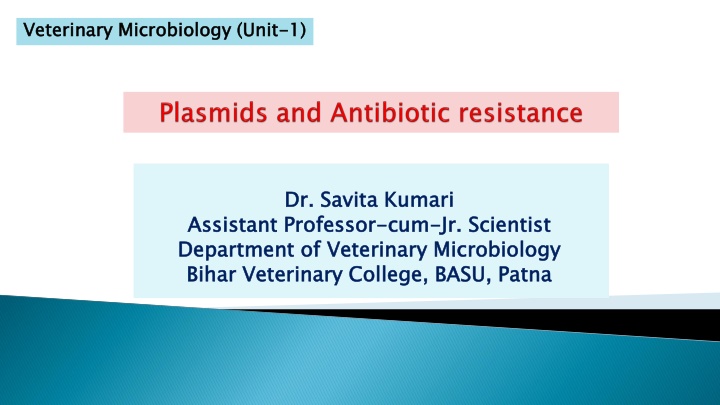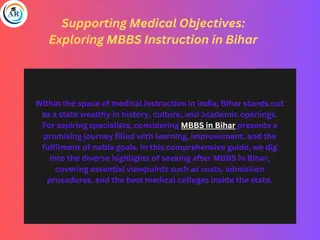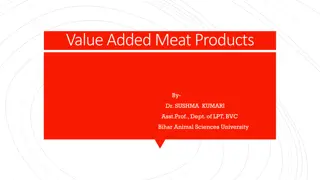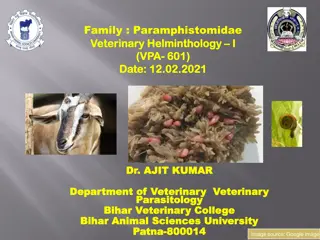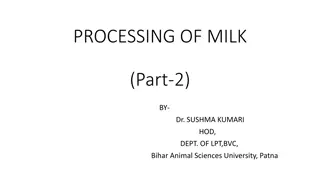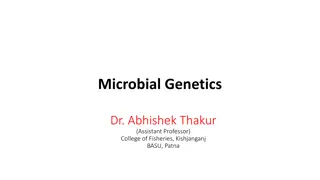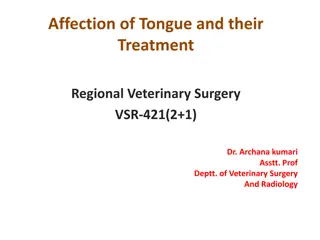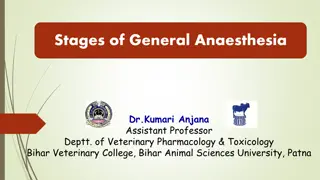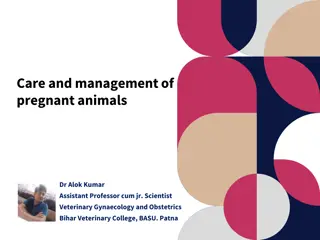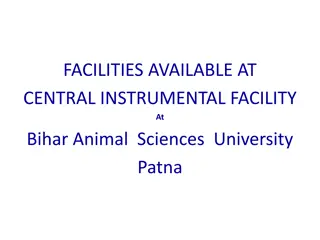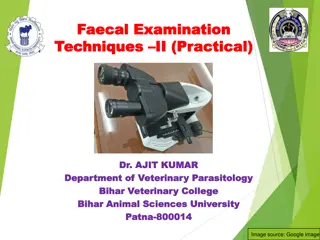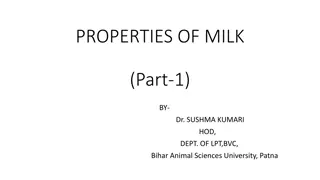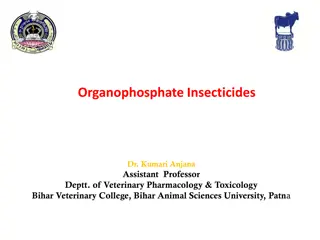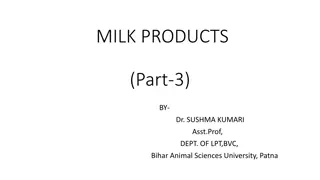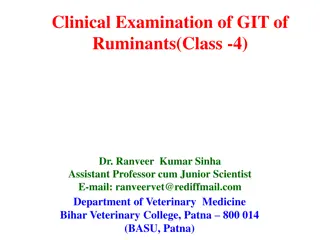Assistant Professor Dr. Savita Kumari at Bihar Veterinary College, BASU, Patna
Dr. Savita Kumari serves as an Assistant Professor in the Department of Veterinary Microbiology at Bihar Veterinary College, BASU, Patna. She is actively involved in teaching and research in the field of Veterinary Microbiology.
Download Presentation

Please find below an Image/Link to download the presentation.
The content on the website is provided AS IS for your information and personal use only. It may not be sold, licensed, or shared on other websites without obtaining consent from the author.If you encounter any issues during the download, it is possible that the publisher has removed the file from their server.
You are allowed to download the files provided on this website for personal or commercial use, subject to the condition that they are used lawfully. All files are the property of their respective owners.
The content on the website is provided AS IS for your information and personal use only. It may not be sold, licensed, or shared on other websites without obtaining consent from the author.
E N D
Presentation Transcript
Veterinary Microbiology (Unit Veterinary Microbiology (Unit- -1) 1) Dr. Savita Kumari Dr. Savita Kumari Assistant Professor Department of Veterinary Microbiology Bihar Veterinary College, BASU, Patna Assistant Professor- -cum Department of Veterinary Microbiology Bihar Veterinary College, BASU, Patna cum- -Jr. Scientist Jr. Scientist
Usually circular, double stranded extrachromosomal DNA molecules, can exist independently of host chromosomes Have their own replication origins Autonomously replicating and stably inherited Present in many bacteria (also in some yeasts and other fungi) Encode traits that are not essential for bacterial viability The term plasmid first introduced by American molecular biologist Joshua Lederberg in 1952
Plasmids and bacterial chromosomes separate replicons Replicon being replicated Replicon- - DNA molecule or sequence, has replication origin, capable of Usually much smaller than bacterial chromosome (< 5 to > several 100 kbp) As large as 2 million base pairs in some bacteria Present in both Gram-positive and Gram-negative bacteria Relatively few genes, generally less than 30 Genetic information not essential to host, bacteria lacking them usually function normally
Also integrated chromosomes be present with as bacterial Episome- plasmid can exist either with or without being integrated chromosome into host s
Single-copy plasmids produce only one copy per host cell Multicopy plasmids- 40 or more per cell Curing Curing- -plasmids can be eliminated from host Cells Spontaneous or induced by treatments that inhibit plasmid replication while not affecting host cell reproduction Some commonly used curing treatments: Acridine mutagens UV and ionizing radiation Thymine starvation Growth above optimal temperatures
Transmissibility of plasmids: Transmissibility of plasmids: Transmissible/ conjugative plasmids: Transmissible/ conjugative plasmids: Transferred from cell to cell by conjugation Large plasmids Contain genes responsible for synthesis of sex pilus and enzymes required for processing transfer of genetic material Usually, one to three copies present in a cell Non Non- -transmissible/ non transmissible/ non- -conjugative plasmids: conjugative plasmids: Cannot be transferred from cell to cell Small Have high copy numbers (typically 10 60 per chromosome)
Contain transfer (tra) genes- genetic materials through conjugation Conjugative plasmids Genes for production of sex pilus, enzymes required for conjugation Also contains genes involved in their own transfer Episomes Bacteria having F-plasmid: F positive (F+), function as donors Bacteria without it : F negative (F ), behave as recipients
plays a major role in conjugation in E. coli , first described About 100 kilobases long Most information for plasmid transfer in tra operon, at least 28 genes Several segments- insertion sequences assist plasmid integration into the host cell chromosome
Conjugative plasmids Two components of R factor : resistance transfer factor (RTF) and resistant determinant (r) RTF - conjugational transfer, required for transfer of the plasmid between bacteria r-determinant carries genes conferring antibiotic resistance
Spread of multiple-drug resistance among bacteria Carry genes for a variety of enzymes that can destroy antibiotics and modify membrane transport system May carry one or more antibiotic resistance gene Resistance to more than one type of antibiotics May also carry genes for resistance to metal ions Carry resistance to certain bacteriophages by coding for the enzymes, e.g., restriction endonucleases that degrade the DNA of the infecting bacteriophages
Competitive advantage Bacteriocins Bacteriocins- - Bacterial proteins that destroy other bacteria Usually act only against closely related strains host unaffected by the bacteriocin it produces kill cells by forming channels in plasma membrane Degrade DNA and RNA Attack peptidoglycan and weaken the cell wall
Col plasmids- genes for synthesis of bacteriocins large self-transmissible plasmids, or small nonconjugative, but mobilizable Colicin directed against E. coli Similar plasmids carry genes for bacteriocins against other species Diphthericin- by Corynebacterium diphtheria Pyocins- by Pseudomonas aeruginosa Some Col plasmids are conjugative and also can carry resistance genes
make their hosts more pathogenic bacterium better able to resist host defense or to produce toxins help bacteria infect humans, animals Adhesive fimbriae in E. coli carry genes for virulence on plasmids e.g. Bacillus anthracis- Toxin, capsule Clostridium tetani- Tetanus toxin usually large, low copy elements usually transmitted between hosts by conjugation
carry genes for enzymes that degrade substances such as aromatic compounds (toluene) pesticides (2,4 dichlorophenoxyacetic acid) sugars (lactose) Cryptic plasmids - No known functions Recombinant plasmids- Plasmids altered in the laboratory, DNA fragments or genes into a plasmid vector, introduced into the bacteria Recombinant plasmid containing foreign DNA - chimera chimera
Survival of the organism Many plasmids control medically important properties of pathogenic bacteria resistance to one or several antibiotics production of toxins synthesis of cell surface structures required for adherence or colonization Plasmids used in genetic engineering - vectors Used to amplify, or produce many copies of certain genes To make large amounts of proteins Gene therapy
.. Antibiotic chemical substances, produced by various microorganisms Antimicrobial substance active against bacteria used to prevent and treat bacterial infections Antibiotic resistance occurs when bacteria change in response to use of antibiotics survive and reproduce in the presence of antibiotic doses that were previously thought effective against them
Production of enzymes Inactivate antibiotics Production of enzymes Enzyme Beta-lactamase destroys penicillins and cephalosporins by splitting the Beta-lactam ring of drug Enzymatic alteration of the target site Enzymatic alteration of the target site Synthesis of modified targets against which the antibiotic has no effect Synthesis of modified targets Alteration of permeability of cell wall not achieved inside bacterial cell Alteration of permeability of cell wall by changing their permeability to the drug- effective intracellular concentration of antibiotic Alteration of metabolic pathways Alteration of metabolic pathways that bypasses the reaction inhibited by the drug Efflux pumps Efflux pumps resistance to many groups of antibiotics including aminoglycosides, quinolones etc.
Resistance by bacteria against antibiotic may be classified as: 1. Non lose their cell wall, non-susceptible to action of cell wall acting drug such as penicillins 1. Non- -genetic basis genetic basis Presence of foreign bodies bacteria in their resting stage 2. 03 types (a) chromosome-mediated resistance- by mutation in the gene 2. Genetic basis Genetic basis (b) plasmid-mediated resistance- mediated by resistance plasmid (c) transposons-mediated resistance Transposons- small pieces of DNA, move from one site of bacterial chromosome to another and from bacterial chromosome to plasmid DNA Many R factors carry one or more transposons (antibiotic resistance transposons Tn3 and Tn4 on R factor plasmid)
Plays very important role in antibiotics usage in clinical practice A high rate of transfer of plasmids from one bacterium to another bacterium takes place by conjugation Plasmids mediate resistance to multiple antibiotics Mostly in Gram negative bacteria
